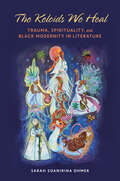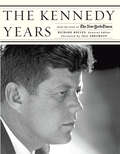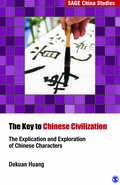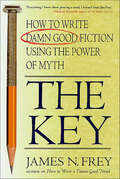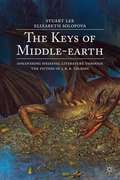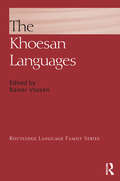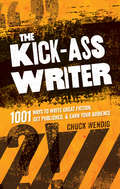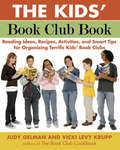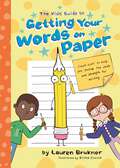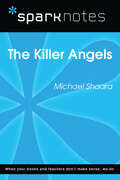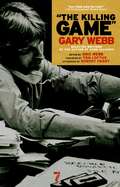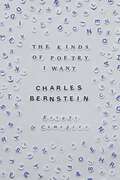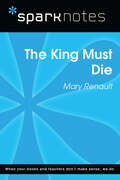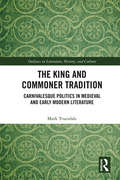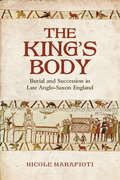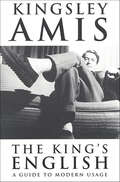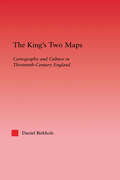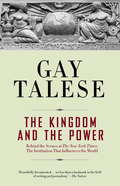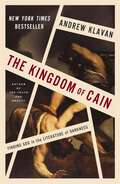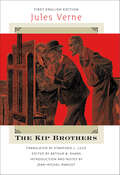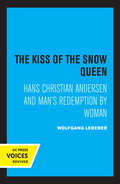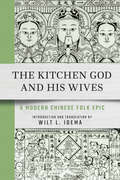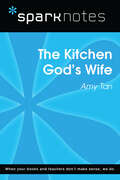- Table View
- List View
The Keloids We Heal: Trauma, Spirituality, and Black Modernity in Literature (Transformations: Womanist studies)
by Sarah Soanirina OhmerWomen of colors and a literature written in corporeal and spiritual scars The corporeal and spiritual healing in literature by women of colors can be seen to redefine modern thought and printed text. Sarah Soanirina Ohmer traces the impact of colonization and enslavement on Black women and Black women’s contributions to colonial, nineteenth, and twentieth century literature in the US, Brazil, and the Caribbean. Drawing on intersectional analysis, Ohmer focuses on portrayals of trauma and spirituality in works by Toni Morrison, Conceição Evaristo, Maryse Condé, Gloria Anzaldúa, the Quilombhoje poets, and María de los Reyes Castillo. Ohmer compares literature from different countries along four thematic pathways: ghosts, mirrors, naming, and motherhood. Her analysis unlocks the literature’s power to heal through gut-wrenching descriptions of wounds and thrilling passages of hope and liberation. Throughout, Ohmer weaves in her life story as a Black woman as she reflects on how colonialism, racism, sexism, and capitalism have impacted her work, traumas, and faith journey.
The Kennedy Years: From the Pages of The New York Times
by Jill Abramson“A deeply illuminating, journalistic romp through Camelot from the eyes and minds of the great New York Times reporters of that era and beyond.” —Douglas Brinkley, #1 New York Times–bestselling authorDecades after the assassination of John F. Kennedy, he still ranks as one of the top five presidents in every major annual survey. To commemorate the man and his time in office, the New York Times has authorized a book, edited by Richard Reeves, based on its unsurpassed coverage of the tumultuous Kennedy era. The Civil Rights Movement, the Bay of Pigs, the Cuban Missile Crisis, Vietnam, the space program, the Berlin Wall—all are covered in articles by the era’s top reporters, among them David Halberstam, Russell Baker, and James Reston. Also included are new essays by leading historians such as Robert Dallek and Terry Golway, and by Times journalists, including Sam Tanenhaus, Scott Shane, Alessandra Stanley, and Roger Cohen. With more than 125 color and black-and-white photos, this is the ultimate volume on one of history’s most fascinating figures.“This book is both fascinating and poignant. It brings us back into the Kennedy years while also allowing us to reflect on what made them so emotional. I found myself totally immersed.” —Walter Isaacson, #1 New York Times–bestselling author“Provides much more than a riveting first draft of history. Here we also witness the birth of modern America.” —Cokie Roberts, former political commentator and #1 New York Times–bestselling author “A terrific introduction to the Kennedy presidency for those who did not live through it, and a startling reminder for those who did of how much happened in those 1,000 days.” —David Nasaw, New York Times–bestselling author
The Key to Chinese Civilization: The Explication and Exploration of Chinese Characters (SAGE China Studies)
by Dekuan HuangThe Key to Chinese Civilization: The Explication and Exploration of Chinese Characters is a fascinating guide to the history of the Chinese civilization, which has been recorded not just by means of the Chinese characters but also in the characters themselves. It studies the long history of Chinese characters, the laws of their construction and development, and what their correct interpretation can mean for contemporary communication. The Chinese writing system, vastly different from phonetic alphabet systems and the oldest continuously used system of writing in the world, is dynamic and its evolution reveals much about the historical and sociocultural development of China. The book shows how the interpretation of the cultural connotation of Chinese characters is necessary, even crucial, though it is a daunting task. It proposes a scientific method for this kind of interpretation and gives elaborate examples. Authored by an expert in philology and palaeography, the book is written in simple language and will be of great help to Chinese language enthusiasts.
The Key: How to Write Damn Good Fiction Using the Power of Myth
by James N. FreyIn his widely read guides How to Write a Damn Good Novel and How to Write a Damn Good Novel II: Advanced Techniques, popular novelist and fiction-writing coach James N. Frey showed tens of thousands of writers how--starting with rounded, living, breathing, dynamic characters--to structure a novel that sustains its tension and development and ends in a satisfying, dramatic climax.Now, in The Key, Frey takes his no-nonsense, "Damn Good" approach and applies it to Joseph Campbell's insights into the universal structure of myths. Myths, says Frey, are the basis of all storytelling, and their structures and motifs are just as powerful for contemporary writers as they were for Homer. Frey begins with the qualities found in mythic heros--ancient and modern--such as the hero's special talent, his or her wound, status as an "outlaw," and so on. He then demonstrates how the hero is initiated--sent on a mission, forced to learn the new rules, tested, and suffers a symbolic death and rebirth--before he or she can return home. Using dozens of classical and contemporary novels and films as models, Frey shows how these motifs and forms work their powerful magic on the reader's imagination.The Key is designed as a practical step-by-step guide for fiction writers and screen writers who want to shape their own ideas into a mythic story.
The Keys of Middle-earth: Discovering Medieval Literature Through The Fiction Of J. R. R. Tolkien
by Stuart Lee Elizabeth SolopovaThe Keys of Middle-Earth uniquely introduces the reader to the world of Medieval Literature through the fiction of J.R.R. Tolkien. Using key episodes in The Hobbit and The Lord of the Rings, readers are taken back to the works of Old, Middle English and Old Norse literature that so influenced Tolkien. The original texts are presented with helpful new translations to help the reader approach the medieval poems and tales, and introductory essays draw on recent scholarship and Tolkien's own unpublished notes. Presenting a new era of Tolkien studies, this book will be of use to students (and teachers) of Medieval/Old English literature and general readers interested in the origins of Tolkien's most widely-known works.
The Khoesan Languages (Routledge Language Family Series)
by Rainer VossenThe Routledge Language Family series is aimed at undergraduates and postgraduates of linguistics and language, and those with an interest in historical linguistics, linguistic anthropology and language development. According to a widely accepted hypothesis, the Khoesan languages represent the smallest of the four language phyla in Africa, geographically distributed mainly in Botswana and Namibia. Today, only 30 or so Khoesan languages may still exist, with about 300,000 native speakers. In other words, most Khoesan languages were already extinct before a sound scholarly interest in them could begin to develop. Drawing together a distinguished group of international experts, with much of the material taken from data collected by the authors’ own field work, this volume presents descriptive, typological, historical-comparative and sociolinguistic material on Khoesan. The Khoesan Languages contains eight sections: an introduction, an overview of genetic relationships, a typological survey and profile of Khoesan, four chapters covering core linguistic areas of Khoesan phonetics and phonology, tonology, morphology and syntax, and a final chapter tackling major issues in Khoesan sociolinguistics, as well as discussions of language contact. Comprehensive and scholarly, yet also lucid in its coverage of a broad range of languages, dialects and sub-groups, this unprecedented and original work represents the current state of Khoesan linguistics.
The Kick-Ass Writer: 1001 Ways to Write Great Fiction, Get Published, and Earn Your Audience
by Chuck WendigThe journey to become a successful writer is long, fraught with peril, and filled with difficult questions: How do i write dialogue? How do I build suspense? What should I know about query letters? Where do I start? The best way to answer these questions is to ditch your uncertainty and transform yourself into a KICK-ASS writer. Chuck Wendig will show you how with an explosive broadside of gritty advice that will destroy your fears, clear the path, and help you find your voice, your story, and your audience. You'll explore the fundamentals of writing, learn how to obtain publication, and master the skills you need to build an army of dedicated fans. No task is too large or small for the kick-ass writer. With his trademark acerbic wit and gut-punch humor, Wendig will explain: How to build suspense, craft characters, and defeat writer's block. How to write a scene, an ending--even a sentence. Blogging techniques, social media skills, and crowdfunding. How to write a query letter, talk to agents, and deal with failure--and success! Whether you're just starting out or you need one more push to get you over the top, two things are certain--a kick-ass writer never quits, and Chuck Wendig won't let you down in this high-octane guide to becoming the writer you were born to be!
The Kids' Book Club Book
by Judy Gelman Vicki Levy KruppThe first complete guide-for use by adults and children-to creating fun and educational book clubs for kids. As authors of The Book Club Cookbook, the classic guide to integrating great food and food-related discussion into book club gatherings, Judy Gelman and Vicki Levy Krupp hear a common refrain from parents, librarians, teachers, community leaders and kids themselves: "How about writing a book for kids' book clubs?" Indeed, in recent years youth organizations, parents, libraries, schools, and our local, state, and federal governments have launched thousands of book clubs for children as a way to counter falling literacy rates and foster a love of reading. Based on surveys representing five hundred youth book clubs across the country and interviews with parents, kids, educators, and librarians, The Kids' Book Club Bookfeatures: _- the top fifty favorite book club reads for children ages eight to eighteen; _- ideas and advice on forming great kids' book clubs-and tips for kids who want to start their own book clubs; _- recipes, activities, and insights from such bestselling children's book authors as Christopher Paolini, Lois Lowry, Jerry Spinelli, Nancy Farmer, Christopher Paul Curtis, Andrew Clements, Laurie Halse Anderson, Norton Juster, and many others. From recipes for the Dump Punch and egg salad sandwiches included in Kate DiCamillo's Because of Winn-Dixie to instructionson how to make soap carvings like the ones left in the knot-hole of a tree in Harper Lee's To Kill a Mockingbird, this book provides a bounty of ideas for making every kids' book club a success.
The Kids’ Guide to Getting Your Words on Paper: Simple Stuff to Build the Motor Skills and Strength for Handwriting
by Lauren BruknerDoes your hand ache when you write? Packed with fun and simple ideas to help kids feel good about writing, this handwriting book with a difference helps children embed the strength and skills they need to get the most out of their written work, at home and school!From different kinds of cushions, hand warm-ups, and cool eye scan exercises, and pencil grips to yoga balls in cardboard boxes, personalized activity binders, playdough, lego, and Velcro on pencils, this book is filled with fun stuff to help kids focus, get stronger, and be in control of their writing. The strategies in the book are accompanied by cartoon-style illustrations, and the author includes useful tips for parents and teachers as well as handy visual charts, a quiz to identify areas of most difficulty, and checklists for children to track their own progress.Armed with the strategies and exercises in this book, kids will be well on their way to writing with greater ease, and the positive self-esteem that goes along with that. Suitable for children with writing difficulties aged approximately 7 to 12.
The Killer Angels (SparkNotes Literature Guide Series)
by SparkNotesThe Killer Angels (SparkNotes Literature Guide) by Michael Shaara Making the reading experience fun! Created by Harvard students for students everywhere, SparkNotes is a new breed of study guide: smarter, better, faster. Geared to what today's students need to know, SparkNotes provides: *Chapter-by-chapter analysis *Explanations of key themes, motifs, and symbols *A review quiz and essay topicsLively and accessible, these guides are perfect for late-night studying and writing papers
The Killing Game
by Gary WebbGary Webb had an inborn journalistic tendency to track down corruption and expose it. For over thirty-four years, he wrote stories about corruption from county, state, and federal levels. He had an almost magnetic effect to these kinds of stories, and it was almost as if the stories found him. It was his gift, and, ultimately, it was his downfall.He was best known for his story Dark Alliance, written for the San Jose Mercury News in 1996. In it Webb linked the CIA to the crack-cocaine epidemic in Los Angeles during the Iran Contra scandal. His only published book, Dark Alliance is still a classic of contemporary journalism. But his life consisted of much more than this one story, and The Killing Game is a collection of his best investigative stories from his beginning at the Kentucky Post to his end at the Sacramento News & Review. It includes Webb's series at the Kentucky Post on organized crime in the coal industry, at the Cleveland Plain Dealer on Ohio State's negligent medical board, and on the US military's funding of first-person shooter video games. The Killing Game is a dedication to his life's work outside of Dark Alliance, and it's an exhibition of investigative journalism in its truest form.
The Kinds of Poetry I Want: Essays & Comedies
by Charles BernsteinA celebration of the radical poetics of invention from Charles Bernstein. For more than four decades, Charles Bernstein has been at the forefront of experimental poetry, ever reaching for a radical poetics that defies schools, periods, and cultural institutions. The Kinds of Poetry I Want is a celebration of invention and includes not only poetry but also essays on aesthetics and literary studies, interviews with other poets, autobiographical sketches, and more. At once a dialogic novel, long poem, and grand opera, The Kinds of Poetry I Want arrives amid renewed attacks on humanistic expression. In his polemical, humorous style, Bernstein faces these challenges head-on and affirms the enduring vitality and attraction of poetry, poetics, and literary criticism.
The King Must Die (SparkNotes Literature Guide Series)
by SparkNotesThe King Must Die (SparkNotes Literature Guide) by Mary Renault Making the reading experience fun! Created by Harvard students for students everywhere, SparkNotes is a new breed of study guide: smarter, better, faster.Geared to what today's students need to know, SparkNotes provides:*Chapter-by-chapter analysis *Explanations of key themes, motifs, and symbols *A review quiz and essay topicsLively and accessible, these guides are perfect for late-night studying and writing papers
The King and Commoner Tradition: Carnivalesque Politics in Medieval and Early Modern Literature (Outlaws in Literature, History, and Culture #4)
by Mark TruesdaleKing and Commoner tales were hugely popular across the late medieval and early modern periods, their cultural influence extending from Robin Hood ballads to Shakespearean national histories. This study represents the first detailed exploration of this rich and fascinating literary tradition, tracing its development across deeply politicized fifteenth-century comic tales and early modern ballads. The medieval King and Commoner tales depict an incognito king becoming lost in the forest and encountering a disgruntled commoner who complains of class oppression and poaches the king’s deer. This is an upside-down world of tricksters, violence, and politicized feasting that critiques and deconstructs medieval hierarchy. The commoners of these tales utilize the inversion of the medieval carnival, crowning themselves as liminal mock kings in the forest while threatening to rend and devour a body politic that would oppress them. These tales are complex and ambiguous, reimagining the socio-political upheaval of the late medieval period in sophisticated ruminations on class relations. By contrast, the early modern ballads and chapbooks see the tradition undergo a conservative metamorphosis. Suppressing its more radical elements amid a celebration of proto-panoptical kings, the tradition remerges as royalist propaganda in which the king watches his thankful subjects through the keyhole.
The King's Body: Burial and Succession in Late Anglo-Saxon England (Toronto Anglo-saxon Ser.)
by Nicole MarafiotiThe King's Body investigates the role of royal bodies, funerals, and graves in English succession debates from the death of Alfred the Great in 899 through the Norman Conquest in 1066. Using contemporary texts and archaeological evidence, Nicole Marafioti reconstructs the political activity that accompanied kings' burials, to demonstrate that royal bodies were potent political objects which could be used to provide legitimacy to the next generation.In most cases, new rulers celebrated their predecessor's memory and honored his corpse to emphasize continuity and strengthen their claims to the throne. Those who rose by conquest or regicide, in contrast, often desecrated the bodies of deposed royalty or relegated them to anonymous graves in attempts to brand their predecessors as tyrants unworthy of ruling a Christian nation. By delegitimizing the previous ruler, they justified their own accession. At a time when hereditary succession was not guaranteed and few accessions went unchallenged, the king's body was a commodity that royal candidates fought to control.
The King's English: A Guide to Modern Usage
by Kingsley AmisA Parthian shot from one of the most important figures in post-war British fiction, The King's English is the late Kingsley Amis's last word on the state of the language. More frolicsome than Fowler's Modern Usage, lighter than the Oxford English Dictionary, and brimming with the strong opinions and razor-sharp wit that made Amis so popular--and so controversial--The King's English is a must for fans and language purists.
The King's Two Maps: Cartography & Culture in Thirteenth-Century England (Studies in Medieval History and Culture #Vol. 22)
by Daniel BirkholzWhile a culture may have a dominant way of "mapping," its geography is always plural, and there is always competition among conceptions of space. Beginning with this understanding, this book traces the map's early development into an emblem of the state, and charts the social and cultural implications of this phenomenon. This book chronicles the specific technologies, both material and epistemological, by which the map shows itself capable of accessing, organizing, and reorienting a tremendous range of information.
The Kingdom and the Power
by Gay TaleseThe classic inside story of The New York Times, the most prestigious, and perhaps the most powerful, of all American newspapers. Bestselling author Talese lays bare the secret internal intrigues behind the tradition of front page exposes in a story as gripping as a work of fiction and as immediate as today's headlines.From the Trade Paperback edition.
The Kingdom of Cain: Finding God in the Literature of Darkness
by Andrew KlavanINSTANT NEW YORK TIMES BESTSELLER • Andrew Klavan explores how artists' imaginative engagement with the darkness can point the way to living beautifully in the midst of a tragic world."Andrew Klavan's book illuminates even as it explores the deepest darkness, finding truth and beauty in art born of unflinching confrontations with evil." --Daniel McCarthy, editor-in-chief, Modern AgeIn his USA Today bestselling The Truth and Beauty, Andrew Klavan explored how the work of great poets helps illuminate the truth of the gospels. Now, the award-winning screenwriter and crime novelist turns his attention to the dark side of human nature to discover how we might find joy and beauty in the world while still being clear-eyed about the evil found in it.The Kingdom of Cain looks at three murders in history--including the first murder, Cain's killing of his brother, Abel--and at the art created from imaginative engagement with those horrific events by artists ranging from Fyodor Dostoevsky to Alfred Hitchcock.To make beauty out of the world as it is--shot through with evil and injustice and suffering--is the task not just of the artist but, Klavan argues, of every life rightly lived. Examining how that transformation occurs in art grants us a vision for how it can happen in our lives.Klavan eloquently argues that it is possible to be clear-eyed about the evil in the world while remaining hope-filled about God's ability to redeem it all.
The Kip Brothers (Early Classics of Science Fiction)
by Jules VerneCastaways on a barren island in the South Seas, Karl and Pieter Kip are rescued by the brig James Cook. After helping to quell an onboard mutiny, however, they suddenly find themselves accused and convicted of the captain's murder. In this story, one of his last Voyages Extraordinaires, Verne interweaves an exciting exploration of the South Pacific with a tale of judicial error reminiscent of the infamous Dreyfus Affair. This Wesleyan edition brings together the first English translation with one of the first detailed critical analyses of the novel, and features all the illustrations from the original 1902 publication.
The Kiss
by Kathryn HarrisonHere comes a true story about A Woman Who Slept with Her Father--prime fodder for the TV talk show feeding frenzy. Certainly it would be easy to lump Kathryn Harrison's new memoir, The Kiss into this same category of titillating topics, but that would be a mistake. There is nothing remotely titillating about Harrison's book; instead, it reads like a slow descent into hell--one that compels and repels in almost equal measure at times. Harrison, who did not really meet her father until she was 20, takes the reader on a difficult journey into her loveless childhood, her bouts with anorexia and bulimia, and, eventually, the incestuous 4-year affair with her father. Her prose is deceptively simple; her choice of present tense to describe events that occurred many years ago forces an immediacy--almost a complicity--upon the reader that heightens both revulsion and compassion. The Kiss is not for everybody. Some readers will be outraged by its subject matter; others will find it just too painful to read. But for those who make it through, this harrowing tale promises the reward of a life reclaimed and a tragedy transcended.
The Kiss of the Snow Queen: Hans Christian Andersen and Man's Redemption by Woman
by Wolfgang LedererThis title is part of UC Press's Voices Revived program, which commemorates University of California Press’s mission to seek out and cultivate the brightest minds and give them voice, reach, and impact. Drawing on a backlist dating to 1893, Voices Revived makes high-quality, peer-reviewed scholarship accessible once again using print-on-demand technology. This title was originally published in 1986.
The Kitchen God and His Wives: A Modern Chinese Folk Epic
by Wilt L. IdemaThe Kitchen God and His Wives is a modern folk epic on the origin of the Stove God, widely venerated across China. In this tale, the Stove God (or Kitchen God) begins as a mortal man who owes his wealth and success to his loyal wife, the long-suffering Guo Dingxiang. Guo's ungrateful husband divorces her, losing his fortune and eventually becoming a beggar. When he receives charity from his former wife, he is filled with remorse and kills himself by jumping into the stove. This act elevates both the man and his wife to godhood. Set in China's countryside and ranging from heaven to hell, this tale provides a look at traditional marriage customs and the uses and abuses of fortune telling in southeastern Henan. This volume contains Wilt L. Idema's full and annotated translation of the Guo Dingxiang epic together with an extensive study of the textualization of this work in the years following the Cultural Revolution. The Kitchen God and His Wives offers a valuable look at Chinese folk culture and traditional storytelling.
The Kitchen God's Wife (SparkNotes Literature Guide Series)
by SparkNotesThe Kitchen God's Wife (SparkNotes Literature Guide) by Amy Tan Making the reading experience fun! Created by Harvard students for students everywhere, SparkNotes is a new breed of study guide: smarter, better, faster. Geared to what today's students need to know, SparkNotes provides: *Chapter-by-chapter analysis *Explanations of key themes, motifs, and symbols *A review quiz and essay topicsLively and accessible, these guides are perfect for late-night studying and writing papers
The Kite Runner (Play Script): Based on the novel by Khaled Hosseini
by Matthew SpanglerThe script for the stage production of Khaled Hosseini's first and internationally bestselling novel, The Kite Runner, as adapted by playwright Matthew Spangler. The unforgettable, heartbreaking story of the unlikely friendship between a wealthy boy and the son of his father's servant, The Kite Runner is a beautifully crafted novel set in a country that is in the process of being destroyed. Now adapted for the stage, the story is about the power of reading, the price of betrayal, and the possibility of redemption, and is an exploration of the influence of fathers over sons--their love, their sacrifices, their lies.A sweeping saga of family, love, and friendship told against the devastating backdrop of the history of Afghanistan over the last thirty years, The Kite Runner is an unusual and powerful story that has become a beloved, one-of-a-kind classic.This adaptation was first performed at Wyndham's Theatre, London, in December 2016.
